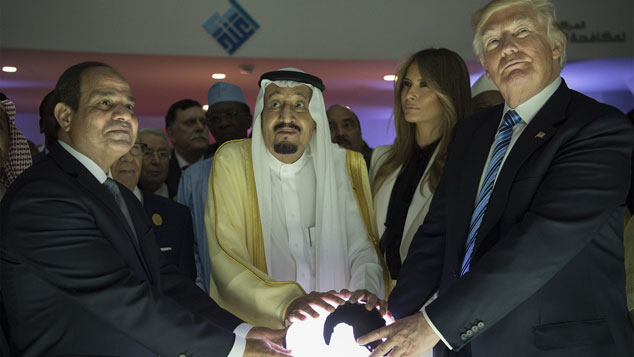
Americans have got used to “the perpetual chaos” caused by their new president, says Dana Milbank in The Washington Post. Over the past week, “lucky friends and allies” in the Middle East got to see the “Trump tornado first hand” as he “bumbled his way through Saudi Arabia and Israel” on his first foreign trip, calling Saudi Arabia’s King Salman “King Solomon” and leaving a “cheerful message” (“so amazing and will never forget!”) in the guestbook at the Holocaust memorial Yad Vashem.
Trump visited Iran’s two “main Middle Eastern foes – Saudi Arabia and Israel” in order to “rally a coalition to contain Tehran’s influence”, says Najmeh Bozorgmehr in the Financial Times. This marks a sharp departure from that of the previous administration, which struck a landmark 2015 nuclear deal with the Islamic Republic, worsening relations with Saudi and Israeli leaders as a result.
Although relations between Saudi Arabia and Israel are so strained that they have no flight links, phone connections or formal diplomatic ties, Trump’s message to the two nations was the same, says John Reed in the FT. “Unite against a common enemy” (Iran and Islamist extremism) and “build on this to resolve the protracted Arab-Israeli conflict”.
Trump posed for photographs alongside King Salman at the launch of the Global Centre for Combating Extremist Ideology, activating a welcome video by touching a glowing miniature globe and thereby providing the media with an image that rapidly “drew comparisons to Hydra, the villainous organisation bent on world domination”, says Elle Hunt in the Guardian.
The US president’s approach to brokering peace between Israel and Palestine is the “latest iteration of his classic deal-making style”, says Karen DeYoung in The Washington Post: “set an audacious target” but instead of charting a course, rely on negotiating skills and persuasion to achieve it.
While Trump “wrapped up” his tour by declaring on Tuesday that “Israeli and Palestinian leaders are ready to strike a peace agreement”, both the Palestinian Authority President Mahmoud Abbas and Israeli Prime Minister Benjamin Netanyahu, provided ample reminders of “the daunting obstacles that stand in the way”, say Carol Lee and Rory Jones in The Wall Street Journal. In Bethlehem on Tuesday, Abbas reiterated demands for a Palestinian state with East Jerusalem as its capital. A day earlier, says DeYoung, when Trump visited the Western Wall in East Jerusalem, Netanyahu pointedly welcomed him to the “eternal capital of the Jewish people, the united capital of the Jewish state”, both descriptions rejected by the Arab world.
It doesn’t help that Trump is “not a neutral party”, says Richard Spencer in the Times. “His east coast, plutocratic wing of the Republican movement has brought him into close contact with wealthy Israeli Americans, including the family of his son-in-law, Jared Kushner” (who has been given the job of foreign peace broker, notes Catherine Philp in the same paper). His ambassador to Israel is a Zionist.
Trump has also refused to commit his administration to the US policy of a two-state solution. According to White House officials, this is to give both sides maximum room for negotiation. However, the omission has frustrated Palestinians and delighted right-wing Israelis. As Al Jazeera’s Hoda Abdel-Hamid notes, his desire for stability in the region is laudable, but many Palestinians will be disappointed by his lack of plan and what he “did not say”.
A scandal that could sink the president
On Tuesday, the former CIA director, John Brennan, gave the “fullest account to date” of the effort to thwart Russian interference in the 2016 US elections, says Julian Borger in The Guardian. Testifying to the House Intelligence Committee, Brennan said that by late summer, there were sufficient contacts between members of Donald Trump’s campaign and Moscow to warrant further investigation by the FBI. He “briefed congressional leaders” and called Alexander Bortnikov, head of Russia’s intelligence agency, FSB, and warned him to “stop the meddling”.
Brennan’s testimony follows the “bombshell” that Trump disclosed highly sensitive information during a meeting with the Russian ambassador and foreign minister earlier this month , says the BBC. Before that, there was the abrupt departure of National Security Advisor, Michael Flynn in February, and revelations of Attorney General Jeff Session’s meeting with Russia’s ambassador Sergey Kislyak.
Then there’s the business of sacked FBI director, James Comey. Trump tried to get Comey to “back off” when Comey confirmed, in March, that the FBI was investigating potential links between Trump’s campaign and Moscow as part of a wider investigation into election meddling, says Massimo Calabresi on Time.com. He then fired him on 9 May, fuelling rumours of a “cover-up”. Trump has repeatedly declared that the Russia story is “fake news” and attempted to “undermine the conclusions of his own intelligence agencies”.
Suddenly the scandal is about Trump’s “discomfort” rather than collusion, says Leonid Bershidsky on Bloomberg. “This is a dangerous bit of bait-and-switch.” What matters is whether the Trump campaign received help from Moscow, and if so, whether it accepted it “wittingly or unwittingly”. “If Putin and Trump – or people working for them – actually made a deal to swing a US election, that calls for impeachment and treason charges. If Trump was complicit… he shouldn’t be president”. I hope that Robert Mueller, the former FBI director who is now leading the probe, will “remember what they’re investigating, and… do an honest job.”